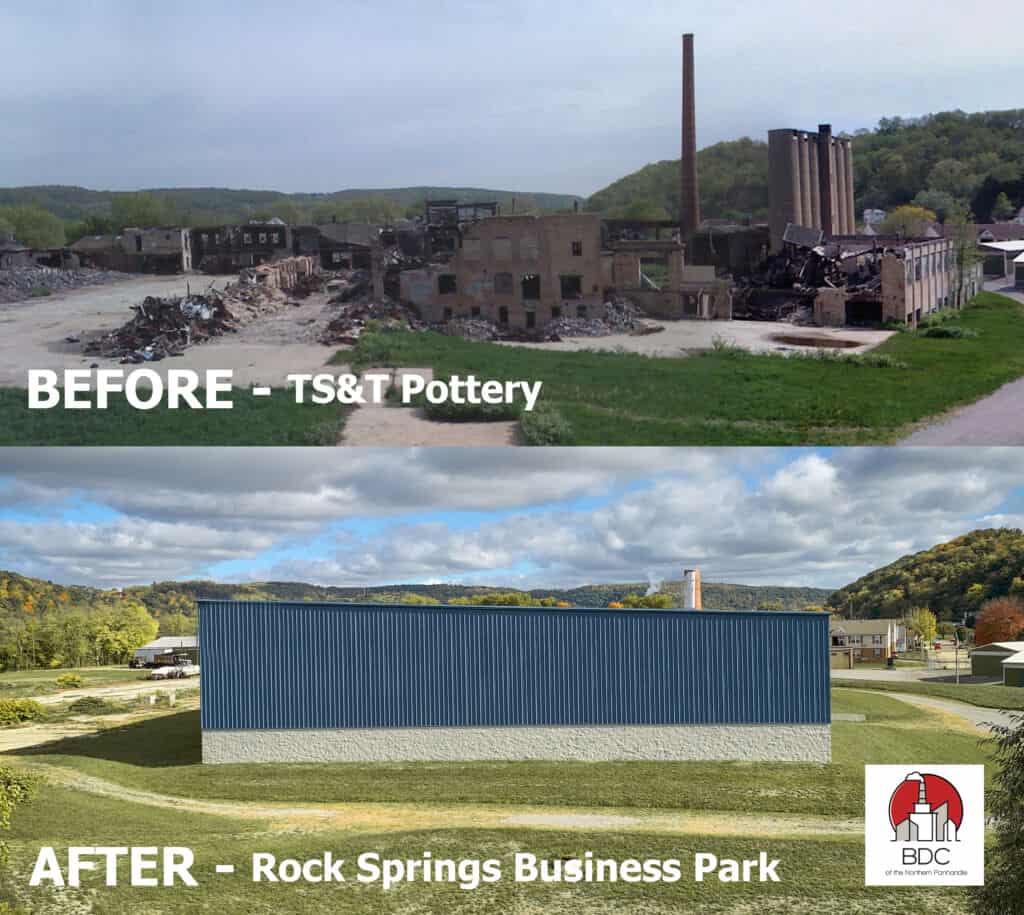The Quick-Start Guide to Understanding, Recognizing, or Buying a Brownfield
What are Brownfields?
January 6, 2021

TS&T Pottery as an abandoned brownfield before site remediation and Rock Spring Business Park after site remediation.
Related Links:
Follow us on social media:
Brownfield is not a term many come across in their daily conversations, but brownfields impact communities in the Ohio Valley region. “Brownfield” is a term used to describe a property or site that may be or is contaminated with pollutants or hazardous substances resulting from the historic uses of the property. A brownfield is commonly a former industrial sites, abandoned railroads, old landfills, and former coal mining sites, although it can be found anywhere. For residents of the northern panhandle, this type of site is nothing new.
Before the U.S. Environmental Protection Agency (USEPA)’s implementation of regulations of pollutants and hazardous products in the 1970s, contamination occurred frequently and was often unknown.
Cleanup of a brownfield can often be expensive, long-term projects. A brownfield can also pose serious challenges for small communities. Before acquiring a potentially contaminated site, it is important to perform “All Appropriate inquiries” on the site to be eligible for innocent landowner liability protections under the Comprehensive Environmental Response, Compensation, and Liability Act (CERCLA). What this means is that a Phase I Environmental Site Assessment (ESA) and, if warranted, a Phase II ESA should be performed by a qualified professional (usually a consultant) prior to the sale or acquisition of the property. This is equally important, not only for liability protection but also for eligibility to federal and state assistance resources. These ESA’s will identify any Recognized Environmental Concerns (REC’s) and will investigate suspected contamination. If the assessments identify contamination, there may be cleanup work required on the property for future development. This can be a sticking point for the redevelopment of these properties, but there are resources available through federal, state, and sometimes local entities.
Although a brownfield project takes persistence, partnerships, and time, the benefits after completing site remediation greatly outweigh the initial costs. The physical and environmental benefits of brownfield cleanup include the removal of community health and safety liabilities, increased tax benefits, increased property values, encouragement of sustainable land use, prevention of sprawling, and creation of local jobs. Depending on the end use, different cleanup standards are applied. By completing a site remediation, brownfields transform from community hassles to community assets that offer excellent opportunities for community and economic development.
At the Business Development Corporation of the Northern Panhandle (BDC), we have worked through multiple cleanup projects and were able to successfully remediate and repurpose previously unusable and undesirable properties. The Taylor Smith and Taylor Pottery (TS&T) was the BDC’s first major undertaking of a contaminated, undesirable eyesore located in the middle of Chester, West Virginia and strategically placed alongside Route 30 and the Ohio River.
The site had sat as an abandoned brownfield since TS&T’s closing in the 1980s. The BDC acquired the property in 2011 and received approximately $600,000 in grants from the USEPA, West Virginia Northern Brownfields Assistance Center (WVNBAC), Claude Worthington Benedum Foundation, and West Virginia Redevelopment Collaborative (WVRC). The site was cleared of the dilapidated factory remains and properly remediated. The Rock Springs Redevelopment Task Force decided to call the site the Rock Springs Business Park. A 30,000 square-foot spec building was erected on the property. The site has received the attention of prospective businesses looking to invest in the area.
Brownfields have been what the hometowns in the northern panhandle of West Virginia have revolved and grown around for generations. As the northern panhandle continues to expand and move forward, our partners and the BDC look to breathe new life into these properties and take the opportunity to provide diverse jobs and industries for the residents in the region.
More resources about brownfields and site remediation:
